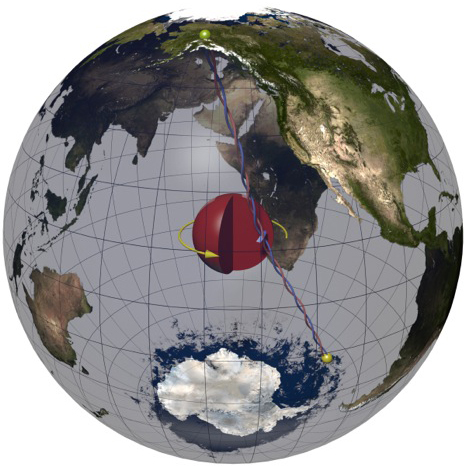
 |
Research School of Earth Sciences - Hrvoje Tkalčić - STUDENTS
|
|
N.B. The scholarships are based on academic merit. Domestic studets with First-class Honors degrees are encouraged to apply for a PhD program and have a great chance to secure a financial support. The PhD admission process for international students is highly competitive, with only a small number of outstanding students receiving an ANU scholarship each academic year.
Link to Jan Dettmer's home page
Link to Malcolm Sambridge's home page
Link to Brian L. N. Kennett's home page
Link to Rhodri Davies' home page
 Degree: PhB, Honours, M.Sc., Summer Scholar Projects
Degree: PhB, Honours, M.Sc., Summer Scholar ProjectsSubject: Deep Earth/Continent evolution, Physics, Geophysics, Seismology
and earthquakes Planet's internal rotation This topic is a subject of active research in geophysical community and was exploited in a recent
science-fiction motion picture The Core (although the scientific facts in the movie were misrepresented to
enhance entertainment). A differential rotation of the inner core with respect to the rest of the mantle was
first suggested from numerical simulations of the geodynamo. Since then, seismological studies aiming to
detect differential rotation of the inner core using temporal changes in seismic waveforms were controversial
and often criticised. One reason for scrutinizing seismological results was inadequate precision to resolve
small temporal changes in inner core properties. However, after the turn of the millennium, earthquake
doublets (repetitive earthquakes that are much less subjected to uncertainties stemming from possible errors
in source parameter determination and structure in the mantle) have been used to confirm the differential
rotation of the inner core. At the same time, the results from normal modes of the Earth were in odds with
the existance of a significant differential rotation. We have recently discovered that the differential
rotation of the inner core with respect to the mantle is variable in time, which reconciled the old
discrepancy in the results from the earthquake doublets and normal modes studies. We found that the inner
core accelerated and decelerated more in recent years, but more data are needed to confirm this observation.
This project is twofold: we will explore a unique dataset from the Australian seismic stations in a search
for new doublets, and we will collect and explore a global dataset of normal modes to approach inner core
rotational dynamics from an independent prospective. A highly motivated student with a background in
geophysics, physics, astronomy or mathematics will find the project challenging and satisfying. Please
contact the supervisor directly at Hrvoje.Tkalcic@anu.edu.au for more information.
Subject: Deep Earth/Continent evolution, Geophysics, Seismology and earthquakes, Computational Studying crustal and upper mantle structure beneath Australia
using multiple geophysical datasets Seismologists combine the so-called receiver functions and surface wave data to improve the
general understanding of crustal and upper mantle structure in various regions of the world. An
important humanitarian objective of obtaining improved structural models is better understanding of
the seismicity and hazard assessment for the region of study. Receiver functions are mostly sensitive
to sharp gradients in Earth's elastic properties (such as the Moho discontinuity), while surface wave
data contribute to a better understanding of overall seismic wave speeds. We are working to develop a
reliable method for the joint modeling of these two types of data, possibly with independent
information from seismic "noise". This project will focus on applying this method to the data
collected by the seismic stations at various regions to better constrain crustal and upper mantle
structure, including features such as the crustal thickness, upper mantle low-velocity zone and
transverse isotropy (polarization anisotropy). Students with a strong computer science, physics or
mathematics background including familiarity with Unix are invited to contact the supervisor at
hrvoje@rses.anu.edu.au for more information.
Subject: Seismology and earthquakes, Geophysics, Computational, Deep Earth/Continent evolution The seismic sources Improved structural models of the Earth and the knowledge about seismic wave propagation allow
seismologists to study earthquake mechanisms. The earthquakes could most generally be divided to
tectonic and volcanic. The far-field radiation of most tectonic earthquakes can be
conveniently described with the so-called double-couple system of forces. However, a full seismic
moment tensor representation is more complete form of the mathematical representation of seismic
sources, especially in non-tectonic environments. Of particular interest are seismic events with
anomalous seismic radiation and puzzling focal mechanisms, such as volcanic earthquakes, mid-ocean
ridge events or explosions.Different computational methods are used to reveal statistically
significant non-double-couple components of the moment tensor and model complex finite sources.
A student with maths and physics background and strong analytical skills is invited to join
the project and assist with analysis and interpretation of results. Please contact the supervisor
directly at hrvoje@rses.anu.edu.au for more information.
|
|
Page last updated: 2007 April 14 Please direct all enquiries to: Hrvoje.Tkalcic@.anu.edu.au Page authorised by: Coordinator, Earth Physics, RSES |
| The Australian National University — CRICOS Provider Number 00120C |